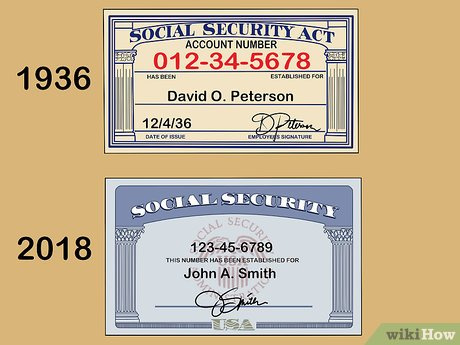Social Security cards are pivotal in verifying identity and employment authorization within the United States. Occasionally, counterfeit versions are produced and used for various unlawful purposes. Recognizing a fake Social Security card is essential for employers, financial institutions, and individuals to prevent fraud and identity theft. Each card follows a standardized format with specific security features, and by knowing what to look for, you can distinguish a genuine card from a counterfeit one.

Check the Paper Quality
When examining a Social Security card, the first thing to look at is the paper it’s printed on. Authentic cards are printed on banknote paper, which is the same type of paper used for currency. This makes the card feel a particular way and provides a high level of durability.
Detailed Steps:
- Feel the Paper: Gently run your fingers over the card. Authentic Social Security cards have a slightly rough texture due to the printing process and should feel similar to US currency.
- Look for the Watermark: Hold the card up to light to check for the presence of a watermark. Genuine cards often have a watermark that can be seen from both the front and the back when held to the light.
- Check for Security Threads: Authentic cards should have small, visible security threads embedded in the paper.
Summary:
Checking the paper quality is a quick initial way to spot a fake Social Security card. While this method is usually effective, some counterfeit cards may still pass this test, so it’s important to use this step in conjunction with others. The benefit of this method is that it’s straightforward and doesn’t require any special equipment.
Inspect the Printing
Social Security cards feature very specific printed details that are hard to replicate perfectly. Looking at the printing closely can reveal if a card is fake.
Detailed Steps:
- Check the Ink: The ink used on a genuine Social Security card is raised; you should feel it when running your fingers over the card number and lettering.
- Examine the Typeface: The font and print quality on authentic cards are consistent. Look for any uneven spacing, different font types, or blurry characters.
- Observe the Alignment: Check if all printed elements on the card are aligned correctly. Misalignments are a common giveaway of a counterfeit card.
Summary:
Inspecting the printing provides observational indicators to validate the authenticity of a Social Security card. The raised ink and precise printing are difficult for forgers to duplicate. While effective, this method requires a keen eye for detail, and even experts can sometimes be fooled by high-quality counterfeits.
Assess the Layout and Formatting
Authentic Social Security cards follow a consistent layout and format that may be difficult for counterfeiters to copy accurately.
Detailed Steps:
- Look at Number Groupings: Social Security numbers are formatted as three groups of digits (XXX-XX-XXXX). Verify that this format is used and the numbers are evenly spaced.
- Examine the Corners: Check that the corners of the card are not rounded or uneven. Genuine cards have uniform, squared corners.
- Verify Information Placement: The cardholder’s name and Social Security number should be centered on the card, spaced properly, and within their respective areas.
Summary:
Assessing the layout and formatting is an effective way to spot inconsistencies and potential alterations. However, some high-quality forgeries may replicate these features well enough to pass a casual inspection, so this method is best used in conjunction with other verification steps.
Observe the Social Security Number (SSN)
A legitimate Social Security number has a specific range and structure that is important to recognize.
Detailed Steps:
- Check the Number Range: The first three digits of the SSN should not be “000,” “666,” or fall in the 900 series. The second set should not be “00,” and the last set should not be “0000.”
- Verify Age and Issuance: Cross-reference the issue date and cardholder’s age. The SSN suggests the timeframe and state where it was issued.
Summary:
Observing the SSN structure can highlight anomalies that don’t align with the Social Security Administration’s issuance patterns. It’s important to note, however, that the Administration occasionally alters issuance patterns, so staying up-to-date on these changes is necessary.
Signature Examination
Genuine Social Security cards require a signature in blue or black ink. Examining the signature may provide clues about authenticity.
Detailed Steps:
- Look at the Signature: It should be in ink, not printed or stamped. Counterfeit cards sometimes use a printed facsimile rather than an actual signature.
- Note the Quality: Check for signs of digital alterations or smudges that might indicate tampering.
Summary:
Signature examination is helpful for spotting clear fakes, but a well-crafted forgery might have a convincing signature. It’s a useful step, but not infallible.
Assess the Laminated Surface
Except in rare instances of older cards, no Social Security card should be laminated or have a plastic coating.
Detailed Steps:
- Check the Card’s Surface: Authentic cards should only have a thin film lamination if they were issued from 1983 to 1992. Recently issued cards should not be laminated at all and should have a matte finish.
- Feel for Excess Material: A card that feels thicker or stiffer than normal may have been laminated, suggesting it’s a fake.
Summary:
While assessing lamination is a straightforward method, consider that some genuine older cards might be laminated, and this doesn’t automatically indicate they are fakes.
Use a Magnifying Glass
Fine details that are not visible to the naked eye can sometimes be spotted with magnification.
Detailed Steps:
- Examine Microprint: Through a magnifying glass, look for microprinting on the card; forgeries often cannot replicate this feature.
- Check for Fine Details: Look for small imperfections or irregularities in the printing, which can indicate a counterfeit.
Summary:
Using a magnifying glass can reveal details that differentiate a genuine card from a fake. The disadvantage is that not everyone has a magnifying glass handy, and spotting these features requires a sharp eye.
Consult the Social Security Administration (SSA)
When in doubt, the SSA can verify the validity of a Social Security number through their verification services.
Detailed Steps:
- Collect Necessary Information: Have the full name, SSN, and, if possible, the date of birth of the cardholder.
- Use the SSA’s Verification Service: Employers can use the Social Security Number Verification Service (SSNVS) for immediate verification.
Summary:
Consulting the SSA is the most definitive way to check a Social Security card’s authenticity but requires access to personal data and can be time-consuming.
Know the Red Flags
Educate yourself on the common mistakes that counterfeiters make when creating fake cards.
Detailed Steps:
- Spot Unusual Features: If the card has decorative elements, icons, or holograms, these are red flags.
- Check for Discolored Areas: Counterfeit cards may have areas where the color is off, especially near the edges or around the numbers.
Summary:
Knowledge of these red flags can prove invaluable; however, some forgeries may not present these obvious mistakes.
Use Technology
Special devices are made for document inspection that can validate the presence of security features.
Detailed Steps:
- Black Light Test: Many official documents have features that only appear under UV light.
- Digital Scanners: Advanced digital scanners can detect discrepancies invisible to the naked eye.
Summary:
Technology provides a high level of scrutiny but can be expensive and is not typically accessible to the general population.
Keep Up with Security Changes
Staying informed about updates to the design and security features on Social Security cards is crucial.
Detailed Steps:
- Follow the SSA Publications: Regularly review updates from the Social Security Administration.
- Attend Seminars or Workshops: Take advantage of educational sessions offered by experts.
Summary:
This is extremely beneficial for maintaining current knowledge but requires regular effort and might not be practical for everyone.
In conclusion, determining the authenticity of a Social Security card involves a combination of tactile, visual, and due diligence checks. While no single method guarantees success, using a blend of these strategies increases the likelihood of spotting a counterfeit. By staying vigilant and informed, one can confidently differentiate between a genuine article and an imitation.
FAQs:
Q: Can I verify a Social Security card’s authenticity online?
A: Yes, employers can use the SSA’s Social Security Number Verification Service (SSNVS) to verify numbers online.
Q: Is it illegal to carry a laminated Social Security card?
A: No, it’s not illegal to carry a laminated Social Security card, though it might make authentication more difficult.
Q: What should I do if I suspect a card is fake?
A: You should not accept a suspected fake Social Security card and should report the suspected fraud to the appropriate authorities.
Q: How often do Social Security cards’ security features change?
A: The SSA updates security features irregularly, so it’s important to stay informed about current card designs and features.









